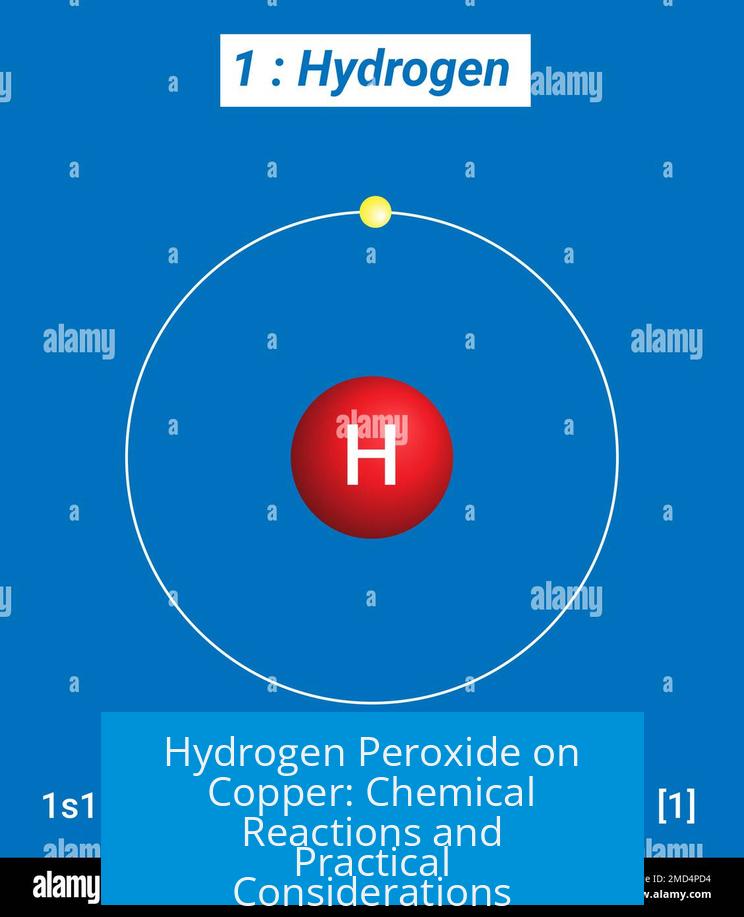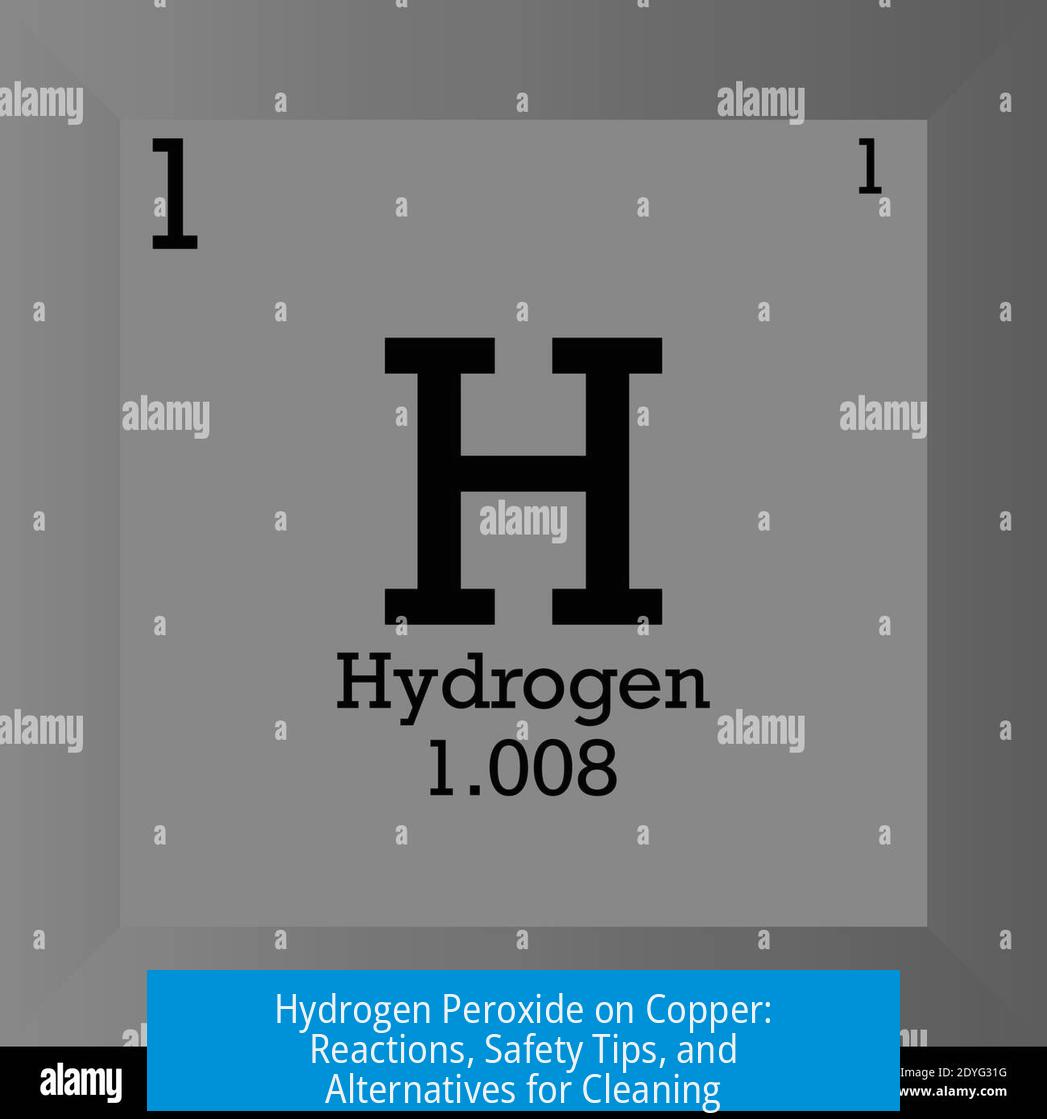Hydrogen Peroxide on Copper: Chemical Reactions and Practical Considerations

Hydrogen peroxide reacts with copper forming copper oxides; copper(II) is reduced to copper(I) oxide while oxygen gas evolves. The process produces soluble copper complexes in alkaline solutions, which have some toxicity. Using hydrogen peroxide for cleaning copper is generally discouraged due to chemical reactivity and safety risks.
1. Chemical Reaction Between Copper and Hydrogen Peroxide
Copper metal interacts with hydrogen peroxide, a strong oxidizer, leading to the formation of copper(II) oxide (CuO). This reaction involves copper being oxidized and hydrogen peroxide decomposing.
The equation illustrating this is:
Cu + H2O2 → CuO + H2O (simplified)
CuO, a black solid, can further react under alkaline conditions. Concentrated sodium hydroxide (NaOH) dissolves CuO to form sodium tetrahydroxycuprate, Na2[Cu(OH)4].
| Compound | Appearance | Solubility | Notes |
|---|---|---|---|
| Copper(II) oxide (CuO) | Black solid | Insoluble in water | Precursor to soluble complexes in NaOH |
| Sodium tetrahydroxycuprate (Na2[Cu(OH)4]) | Colorless/blue solution | Soluble in water | Somewhat toxic |
This soluble copper complex is of concern due to toxicity. It indicates that copper surfaces exposed to hydrogen peroxide and then alkaline solutions can generate harmful species.
2. Copper(II) and Hydrogen Peroxide Reaction Mechanism
The reaction is not limited to direct oxidation of copper metal. Copper ions in the +2 oxidation state (Cu2+) also actively oxidize hydrogen peroxide.
The process yields oxygen gas (O2) and a bright orange precipitate identified as copper(I) oxide (Cu2O).
2 Cu2+ + H2O2 → 2 Cu+ + O2 + 2 H+
Followed by the formation of copper(I) oxide:
2 Cu+ + H2O → Cu2O (orange precipitate) + 2 H+
This characteristic orange color evidences the partial reduction of copper(II) to copper(I) and shows oxygen evolution from hydrogen peroxide decomposition catalyzed by copper ions.
3. Additional Oxidation: Role of Tartrate Ions
Introducing tartrate ions in the system leads to further oxidation by hydrogen peroxide.
Tartrate (C4H4O62-) oxidizes to produce carbon dioxide (CO2), formate ions (HCOO-), and water (H2O), showing the strong oxidative capability of H2O2.
The generalized reaction is:
Tartrate + H2O2 → CO2 + HCOO- + H2O
This demonstrates the capacity of hydrogen peroxide in the presence of copper to oxidize organic ligands, producing simpler compounds.
4. Practical Advice and Safety Considerations
Despite hydrogen peroxide’s oxidative power, its use for cleaning copper or other metals is discouraged.
- Hydrogen peroxide reacts chemically with copper, potentially damaging the metal surface.
- The formation of toxic, soluble copper complexes (like Na2[Cu(OH)4]) poses environmental and health risks.
- Use of hydrogen peroxide in combination with copper-containing equipment—for example, in cleaning brewery tanks—is unsafe. The reactions can degrade metal and release harmful substances.
The so-called “piranha solution” (a mix of hydrogen peroxide and sulfuric acid) is particularly unsuitable when copper is present because of intense oxidation and corrosion.
5. Safer Alternatives for Cleaning Copper
Safer and more conventional copper cleaning agents include:
- Vinegar and Salt: Mild acidic solution plus chloride ions effectively remove copper tarnish without harsh reactions.
- Food-grade Sodium Hydroxide and Nitric Acid: Can clean copper surfaces under controlled conditions with proper materials compatibility.
These alternatives avoid producing toxic soluble copper species and minimize metal degradation.
6. Environmental and Regulatory Restrictions
Environmental and safety protocols can restrict the use of chemicals and abrasive agents in specific settings such as industrial or research environments.
For instance, introducing unapproved substances like sand or unregulated cleaners requires prior approval from environmental and chemical engineering departments.
This ensures that cleaning procedures do not contaminate the environment or compromise chemical safety standards. Non-consumable coatings like specialized paper may be used instead.
Summary of Key Points
- Copper reacts with hydrogen peroxide producing copper oxide (CuO) and oxygen gas.
- Copper(II) ions oxidize H2O2, yielding copper(I) oxide (Cu2O) as a bright orange precipitate.
- Hydrogen peroxide can oxidize organic ions like tartrate into CO2, formate ions, and water.
- Using hydrogen peroxide for cleaning copper is discouraged due to corrosion and toxic complex formation.
- Vinegar and salt, or controlled use of sodium hydroxide and nitric acid, offer safer copper cleaning alternatives.
- Environmental and safety rules may restrict chemical cleaning agents and methods in certain settings.





Leave a Comment